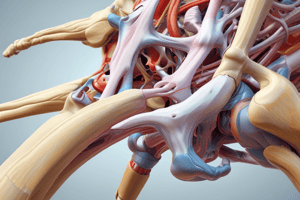Podcast
Questions and Answers
What is a primary function of the skeletal system related to muscle movement?
What is a primary function of the skeletal system related to muscle movement?
- Generating blood cells for oxygen transport
- Stabilizing joints to prevent injury
- Providing movement by serving as points of attachment for muscles (correct)
- Exerting force through contraction
Which type of muscular contraction occurs when a muscle shortens?
Which type of muscular contraction occurs when a muscle shortens?
- Isometric contraction
- Eccentric contraction
- Static contraction
- Concentric contraction (correct)
What distinguishes ligaments from tendons within the muscular and skeletal systems?
What distinguishes ligaments from tendons within the muscular and skeletal systems?
- Ligaments form the skeletal system while tendons are part of the muscular system
- Ligaments stabilize joints while tendons facilitate movement of bones (correct)
- Ligaments are more elastic than tendons
- Ligaments attach bones to muscles while tendons connect muscles to bones
In the anatomical nomenclature, what does the term 'origin' refer to?
In the anatomical nomenclature, what does the term 'origin' refer to?
Which part of the skeletal system is primarily responsible for forming the framework of the body?
Which part of the skeletal system is primarily responsible for forming the framework of the body?
What does the term 'medial' refer to in anatomical references?
What does the term 'medial' refer to in anatomical references?
Which of the following describes a biarticular muscle?
Which of the following describes a biarticular muscle?
In which plane of motion does flexion and extension primarily occur?
In which plane of motion does flexion and extension primarily occur?
What does the term 'prone' describe?
What does the term 'prone' describe?
Which axis of rotation is associated with the frontal plane?
Which axis of rotation is associated with the frontal plane?
Which of the following movements is best described by the term 'adduction'?
Which of the following movements is best described by the term 'adduction'?
What is the correct description of 'superior' in anatomical references?
What is the correct description of 'superior' in anatomical references?
What does the term 'contralateral' imply?
What does the term 'contralateral' imply?
Flashcards
Structural Kinesiology
Structural Kinesiology
The study of human movement by identifying anatomical elements.
Skeletal System Functions
Skeletal System Functions
Provides framework, movement, protection, stores minerals, and forms blood.
Types of Muscular Contractions
Types of Muscular Contractions
Isometric (same length), Concentric (shortening), Eccentric (lengthening).
Tendon
Tendon
Signup and view all the flashcards
Ligament
Ligament
Signup and view all the flashcards
Anatomical Position
Anatomical Position
Signup and view all the flashcards
Anterior
Anterior
Signup and view all the flashcards
Posterior
Posterior
Signup and view all the flashcards
Medial
Medial
Signup and view all the flashcards
Lateral
Lateral
Signup and view all the flashcards
Sagittal Plane
Sagittal Plane
Signup and view all the flashcards
Flexion
Flexion
Signup and view all the flashcards
Prone
Prone
Signup and view all the flashcards
Study Notes
Course Information
- Course: KINE 2850 Structural Kinesiology
- Lecture: 1 - Introduction
- Institution: East Carolina University
- Location: Greenville, NC
Structural Kinesiology Definition
- Structural kinesiology combines the anatomical elements of the human body with kinesiology, the study of human movement.
- It analyzes movement by identifying anatomical elements within the body.
Skeletal System
- Structure: The skeletal system includes rigid bones (though not entirely rigid) and flexible joints, which are also not entirely flexible.
- Axial skeleton: Includes the trunk, spine, neck, and head.
- Appendicular skeleton: Consists of upper and lower extremities.
- Functions:
- Framework: Providing a basic framework for the body.
- Movement: Acting as attachment points for muscles, and functioning as levers for movement.
- Protection: Offering protection to internal organs.
- Mineral storage: Storing minerals.
- Blood formation: Producing blood cells.
Types of Joints
- There are 6 major types of joints:
- Hinge
- Ball and socket
- Pivot
- Saddle
- Gliding
- Condyloid
Muscular System
- Function: Exerting force through contraction.
- Types of contractions:
- Isometric: Muscle contracts but does not shorten (holds a position).
- Concentric: Muscle shortens (starts a movement).
- Eccentric: Muscle lengthens (stops or decelerates a movement).
- Muscle Nomenclature: Examples include Flexor digiti minimi. Includes:
- Origin: Proximal attachment point.
- Insertion: Distal attachment point.
- Line of pull (action/outcome): The muscle's action or result
- Impacts force production
Other Connective Tissues
- Tendon: Attaches muscle to bone to allow for movement.
- Ligament: Attaches bone to bone to provide stability to joints.
Anatomical Position
- Anatomical Position: A standard reference point for the body, with palms facing forward.
- All anatomical descriptions refer to this position.
Anatomical References
- Directional terms:
- Anterior: front of the body
- Posterior: back of the body
- Medial: toward the middle
- Lateral: toward the side
- Superior: above
- Inferior: below
- Proximal: nearest to the trunk
- Distal: farthest from the trunk
- Other terms:
- Superficial: near the surface
- Deep: beneath the surface
- Prone: lying face down
- Supine: lying face up
- Contralateral: relating to the opposite side
- Ipsilateral: relating to the same side
- Biarticular: crossing two joints directly
- Uniarticular: crossing one joint directing
Planes of Motion
- Sagittal: Divides the body into left and right halves.
- Transverse (Axial): Divides the body into top and bottom halves.
- Frontal (Coronal): Divides the body into front and back halves.
Axes of Rotation
- Anteroposterior: Rotational axis for movements occurring in the frontal plane.
- Mediolateral (Transverse): Rotational axis for movements occurring in the sagittal plane.
- Longitudinal: Rotational axis for movements occurring in the transverse plane.
General Movements
- Primary Movements—examples include:
- Flexion
- Extension
- Abduction
- Adduction
Studying That Suits You
Use AI to generate personalized quizzes and flashcards to suit your learning preferences.




